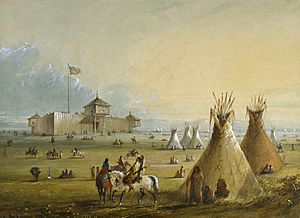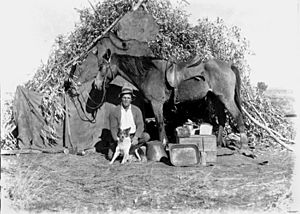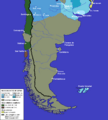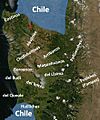Frontiersman facts for kids

Frontiersmen and frontierswomen were brave people who lived on the edge of settled areas. This "frontier" was the border between towns and the wild, unknown wilderness. These pioneers often cleared land, built homes, and grew food. They also hunted animals for meat and used their furs for clothing.
Some famous American frontiersmen include Davy Crockett, Daniel Boone, and Kit Carson. You could find many frontiersmen and women in countries like the United States, Canada, and Australia.
Contents
Russia's Expanding Frontier
For many centuries, Russia also had its own expanding frontiers. These were in the north, south (called the Wild Fields), and east (like Siberia and Alaska). As Russia grew, new frontier areas appeared. Often, Cossacks – a group of skilled horsemen and warriors – helped settle these new lands.
Australia's Frontier Experience
In Australia, the word "frontier" meant the land bordering the unknown or wild areas. It was the edge of where people had settled. People living on this edge were sometimes called "outsiders." The "outside districts" were the areas beyond the settled parts.
The term "frontier districts" was often used in early Australian newspapers. It described fights between European settlers and Indigenous Australians. For example, a newspaper in 1850 talked about violence on the northern frontier. It asked for protection for settlers, suggesting that a strong group of Native Police was needed to keep order.
North America's Frontier Life
In North America, the "frontier" was a region at the edge of settled areas. It was a place where explorers and pioneers arrived. Historian Frederick Jackson Turner believed that moving into the frontier changed people. For example, he said that the chance to get free land gave people hope and a sense of endless opportunity. This led to optimism and a focus on the future.
When Europeans first settled the Atlantic coast, the frontier was the wild forest beyond their small towns. These towns were usually along rivers like the St. Lawrence, Connecticut, and Hudson.
Different Ways of Settling
English, French, Spanish, and Dutch settlers expanded in different ways. Only a few thousand French people moved to Canada. They settled in villages along the St. Lawrence River. French fur traders traveled far into the Great Lakes and Mississippi River areas. But they usually did not settle down.
The English colonies aimed to settle the land more widely. They wanted to farm and use the land's resources. English settlements were often small and compact. Conflicts with Native Americans often happened because of who would control the land. Early frontier areas east of the Appalachian Mountains included the Connecticut River valley.
After the French and Indian Wars in the 1760s, the British took over French lands west of the Appalachians. Americans then began moving into areas like the Ohio Country. Most frontier movement was from east to west. But in places like New England, the frontier was to the north. In Florida, it was to the south.
Canada's Unique Frontier
Canadian historians like Harold Adams Innis and J. M. S. Careless studied the Canadian frontier. They focused on how the settled areas (the "center") related to the wilder areas (the "periphery"). In Canada, the idea of the "West" is also linked to the "North." This is seen in Canadian stories, often called the "garrison mentality."
The Quebec frontier was different from the American one. It did not show as much individualism or democracy. The Nova Scotia and Ontario frontiers were more democratic. But experts still debate if this was because of self-reliance on the frontier or because many American immigrants moved there.
Settling the Canadian Prairies
Settlement of the Canadian prairies began in 1896. This was after the American prairie states were already established. Pioneers then moved north to what was called the "Last Best West."
Before settlers arrived, the North-West Mounted Police were sent to the region. This meant that law and order were already in place when people arrived. The lawlessness seen in the American "Wild West" did not happen in Canada. The government also made treaties with the Native peoples. This helped create peaceful relations. It also meant that the long wars with Native Americans seen in the United States mostly did not happen in Canada.
The United States Frontier

After the American Revolutionary War and the Treaty of Paris in 1783, the United States gained control of lands west of the Appalachians. Thousands of settlers, like Daniel Boone, had already reached Kentucky and Tennessee. Some areas, like parts of Ohio, were given to war veterans. How to include these new frontier areas into the nation was a big question. The Northwest Ordinance of 1787 helped solve this.
For the next 100 years, the nation expanded into these areas. This included the Louisiana Purchase, Oregon Country, and Mexican Cession. Hundreds of thousands of settlers moved there. The question of whether the Kansas frontier would allow slavery or be "free" helped start the American Civil War. Before 1860, Northern Democrats wanted easy land ownership. Southern Democrats and Whigs often disagreed. Southerners did not want Homestead Acts because they would create more free farmers who might oppose slavery.
When the Republican Party came to power in 1860, they supported free land. The Homestead Act of 1862, along with railroad land grants, offered cheap land to settlers. By 1890, the frontier line had mostly disappeared. The Census Bureau said the frontier line was where the population density was less than two people per square mile.
The frontier had a huge impact on American culture. It appeared in dime novels, Wild West shows, and later, in Western movies. Historian Frederick Jackson Turner said that the frontier was key to defining the United States. He presented his Frontier Thesis in 1893. The frontier is also seen as a place where two cultures met. This contact led to changes for both cultures.
Images for kids
-
A restored pioneer house at the National Ranching Heritage Center in Lubbock, Texas, US.
-
De facto Spanish territories and indigenous territories around 1800. Viceroyalty of the Río de la Plata is shown in blue while the Captaincy General of Chile is shown in green.
-
Mapuche groups in Araucanía around 1850. De facto Chilean territory in blue.






